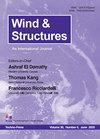桥隧过渡对有侧风和无侧风列车空气动力学性能影响的比较研究
IF 1.9
4区 工程技术
Q3 CONSTRUCTION & BUILDING TECHNOLOGY
引用次数: 5
摘要
本文基于计算流体力学(CFD)方法,研究了高速列车在有无侧风的情况下,从平坦地面进入桥梁和进出隧道的情况。首先,对流动结构进行了分析,解释了不同基础设施对列车气动特性的影响机理。然后,对列车在整个过程中的气动力演化进行了分析和比较。此外,还对列车车体和隧道壁的压力变化进行了详细分析。结果表明:在无侧风情况下,高速列车两侧的压力系数和流动结构是对称的;而在侧风作用下,列车通过桥隧段时,压力分布和水流结构会发生巨大而直接的变化。地桥过渡段对气动力的影响远小于桥隧段。此外,在进入和退出桥隧段的过程中,气动载荷的变化也很显著。此外,在无侧风情况下,隧道内压力变化符合压力波传播规律,而在侧风情况下,隧道内压力变化综合受到列车和侧风的影响。本文章由计算机程序翻译,如有差异,请以英文原文为准。
Comparison study of the effect of bridge-tunnel transition on train aerodynamic performance with or without crosswind
This paper studied the case of high-speed train running from flat ground to bridges and into/out of tunnels, with or
without crosswind based on the Computational Fluid Dynamics (CFD) method. First, the flow structure was analyzed to explain
the influence mechanisms of different infrastructures on the aerodynamic characteristics of the train. Then, the evolution of
aerodynamic forces of the train during the entire process was analyzed and compared. Additionally, the pressure variation on the
train body and the tunnel wall was examined in detail. The results showed that the pressure coefficient and the flow structure on
both sides of the high-speed train were symmetrical for no crosswind case. By contrast, under crosswind, there was a
tremendous and immediate change in the pressure mapping and flow structure when the train passing through the bridge-tunnel section. The influence of the ground-bridge transition on the aerodynamic forces was much smaller than that of the bridge-tunnel section. Moreover, the variation of aerodynamic load during the process of entering and exiting the bridge-tunnel sections was both significant. In addition, in the case without crosswind, the change in the pressure change in the tunnel conformed to the law of pressure wave propagation, while under crosswind, the variation in pressure was comprehensively affected by both the train and crosswind in the tunnel.
求助全文
通过发布文献求助,成功后即可免费获取论文全文。
去求助
来源期刊

Wind and Structures
工程技术-工程:土木
CiteScore
2.70
自引率
18.80%
发文量
0
审稿时长
>12 weeks
期刊介绍:
The WIND AND STRUCTURES, An International Journal, aims at: - Major publication channel for research in the general area of wind and structural engineering, - Wider distribution at more affordable subscription rates; - Faster reviewing and publication for manuscripts submitted.
The main theme of the Journal is the wind effects on structures. Areas covered by the journal include:
Wind loads and structural response,
Bluff-body aerodynamics,
Computational method,
Wind tunnel modeling,
Local wind environment,
Codes and regulations,
Wind effects on large scale structures.
 求助内容:
求助内容: 应助结果提醒方式:
应助结果提醒方式:


